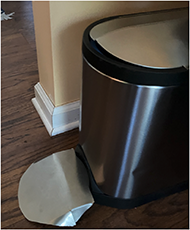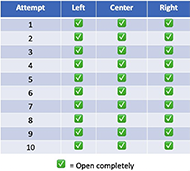Just Roll On It - Design Brief
Brittany Platt
Background
One may not think of depositing items into a trash can as an instrumental activity of daily living (IADL); however, throwing away trash is important part of housekeeping. It is important for hygiene and maintaining the living environment. IADLs are different for every person, as they are dependent on the person's lifestyle. Assistive technology may be useful in helping. Person to accomplish these IADLS.
The "Just Roll on It" device is an extension ramp for an existing step on trash can. It allows the user to open the trash can lid by using the caster of their wheelchair to activate the lever. The intent is for somebody who is in a wheelchair to be able to throw garbage away and keep their house tidy. When the client has very limited hand function and is using a wheelchair, they may be limited to what type of trash they can use.
Problem Statement
An Individual in a wheelchair with limited hand mobility needs to have a trash can that will open on the ground to help assist in keeping their house clean.
Research Question
Will a ramp extension attached to an existing trash receptacle allow the lid to be opened by persons in wheelchairs with different caster sizes from various angles? The specific aim is to construct a ramp that allows a person using a wheelchair to effectively open a trash can lid.
Methods/Approach/Solutions Considered:
I. Virtual Approach to Design
The client lives in Texas and participated in a virtual class experience, describing the challenges associated with the use of his trash receptacle. He described an issue of crashing into the existing trash can and damaging the device. The client provided feedback on various suggestions through class dialogue and the affinity diagrams found in Appendix A.
II. Construction of prototype
Based on feedback from the client and course instructors several design sketches were created. It was decided that a ramp extension would be most appropriate. A ramp that would allow the can to open when the front caster rolled onto the ramp was proposed. The client suggested changes to the design to allow access from three sides of the ramp. Design sketches are included in Appendix B.

Using the design of the client, 16-gauge sheet metal was purchased at Home Depot and a protype was cut out using a jig saw and metal blade. The bends were created using a vice and hammer in my driveway. The client's idea was unsuccessful as the side ramp did not allow for flexing of the ramp. To overcome this lack of flex, cuts were made in the side ramps.
III. Testing of prototype
This design still proved ineffective. The ramp would not provide enough flex to open the trashcan from all sides.

A new prototype design was created. The center ramp followed the existing design; to ensure flex of the side ramps, a pair of 3-1/2-inch hinges were welded to the side ramps.

The initial testing validation plan proposed was an 80% success rate using two different manual wheelchairs, from each side of the trash can. In the validation test, the lid was able to be opened from each side 100% of the time.
IV. User feedback from solution
The revised protype was tested with success and presented to the class and client for feedback. The client was very excited and had excellent comments about the ramp extension. It was suggested that the sharp edges be changed to reduce risk of injury and for aesthetics.
V. Solutions Considered from new feedback
Based on the new feedback the corners of the ramp were rounded to reduce the risk of injury. Skid Guard stair tread tape was applied to all surfaces and edge protector was added to reduce sharp edges.
Description of Final Approach and Design

The final design incorporated feed back from the original design through the validation testing and final presentation to the client and class. The final product includes a 16-guage pedal with side ramps attached using 3-1/2 inch hinges welded to the main and side ramps. The side ramps now have rounded edges, Skid Guard Tread, and rubber edging.
Outcome:
Throughout the design process, user feedback was crucial. The design followed an iterative process of design, test, feedback, redesign. This allowed for suggestions and improvements to reach the final product. Functional testing was performed by the developer using manual wheelchairs available in the RST labs. Due to lack of availability, it was not tested with a power assist and or power wheelchair.
Cost
The estimated for the total cost of the device, including the trash can is $133.61.
Quantity |
Item |
Cost |
1 |
SimpleHuman 10L Butterfly Trash Can |
$70.00 |
1 |
16-guage sheet metal |
$29.89 |
2 |
3-1/2-inch hinge |
$7.96 |
2 |
Skid Guard Tread |
$15.98 |
1 |
Edge protector |
$7.99 |
2 |
¼ inch pan head screws and nuts |
$1.79 |
Significance
The intent is to create a reliable trash can ramp that will allow a client using a wheelchair to be able to independently place items in the trash without damaging the trashcan. It is important that the client be able to maintain the cleanliness of his house in an independent manner. It is also important that the trash can is damaged in the process as this is not cost effective. This device has universal practical application to all pedal operated trash cans.
Figure 5 - Affinity Diagram 1

Figure 6 - Affinity Diagram 2

Appendix B

The client's


Acknowledgements
The Just Roll on It would like to acknowledge the efforts of our professors Alexandra Delazio, Todd Hargroder, and Dr. Dave Brienza as well as the teaching assistant Taychapat Makkong. A special thanks to Todd Hargroder for being the primary user, for the feedback throughout the process. Without the assistance and expertise in welding by Mr. David Allison the completion of the prototype and final design would not have been possible.